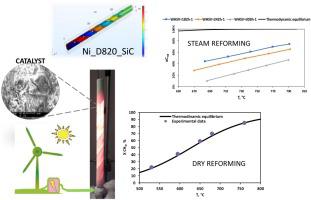Catalysis Today ( IF 5.2 ) Pub Date : 2020-12-07 , DOI: 10.1016/j.cattod.2020.11.020 Simona Renda , Marta Cortese , Giuseppina Iervolino , Marco Martino , Eugenio Meloni , Vincenzo Palma

|
This article presents a study on the electrification of reforming processes, in which the heat required for the reaction is directly supplied by the surface of the structured catalyst, realized by using commercial silicon carbide (SiC) heating elements as catalyst carriers, so eliminating all resistances to heat transfer. Three commercial ceramic supports were loaded with a 5 wt% nickel and tested in the steam reforming reaction. The best performance was obtained by the silica-mullite composite based support with the highest specific surface area. The structured catalyst was prepared by washcoating a SiC heating element, using a slurry based on the silica-mullite composite, subsequently impregnated in a solution of the nickel precursor, and tested in the steam and dry reforming reactions. The experimental tests were properly designed in order to reach the goals of (i) obtaining the kinetic parameters for the MSR reaction, and (ii) evaluating the energy consumption for both processes. The catalysts were characterized by means of X-ray diffraction, specific surface area, ED-XRF, SEM-EDS and Hg porosimetry. The results of the tests demonstrated that is possible to heat the system up to 800 °C, and sustain the reaction obtaining a methane conversion higher than 85 % both in the case of steam and dry reforming. The analysis of the energy consumption in terms of kWh Nm−3H2 has shown that it is comparable with the one of the modern electrolysers. The results of these experiments unequivocally demonstrate that it is possible to realize a process by reversing the flow of heat, from the inside of the catalytic bed to the outside.
中文翻译:

用于强化重整过程的电驱动 SiC 基结构化催化剂
本文介绍了重整过程的电气化研究,其中反应所需的热量直接由结构催化剂的表面提供,通过使用商用碳化硅 (SiC) 加热元件作为催化剂载体实现,因此消除了所有电阻到热传递。三种商用陶瓷载体负载 5% 的镍并在蒸汽重整反应中进行测试。具有最高比表面积的基于二氧化硅-莫来石复合材料的载体获得了最佳性能。结构化催化剂通过使用基于二氧化硅-莫来石复合材料的浆料涂覆 SiC 加热元件来制备,随后浸渍在镍前体的溶液中,并在蒸汽和干重整反应中进行测试。实验测试经过适当设计,以达到 (i) 获得 MSR 反应的动力学参数和 (ii) 评估两个过程的能耗的目标。通过 X 射线衍射、比表面积、ED-XRF、SEM-EDS 和 Hg 孔隙率测定法对催化剂进行表征。测试结果表明,在蒸汽和干重整的情况下,可以将系统加热至 800 °C,并维持反应,获得高于 85% 的甲烷转化率。以 kWh Nm 为单位的能耗分析 测试结果表明,在蒸汽和干重整的情况下,可以将系统加热至 800 °C,并维持反应,获得高于 85% 的甲烷转化率。以 kWh Nm 为单位的能耗分析 测试结果表明,在蒸汽和干重整的情况下,可以将系统加热至 800 °C,并维持反应,获得高于 85% 的甲烷转化率。以 kWh Nm 为单位的能耗分析-3 H 2已表明它与现代电解槽之一相当。这些实验的结果明确表明,可以通过使热量从催化床内部流向外部的反向流动来实现一个过程。











































 京公网安备 11010802027423号
京公网安备 11010802027423号